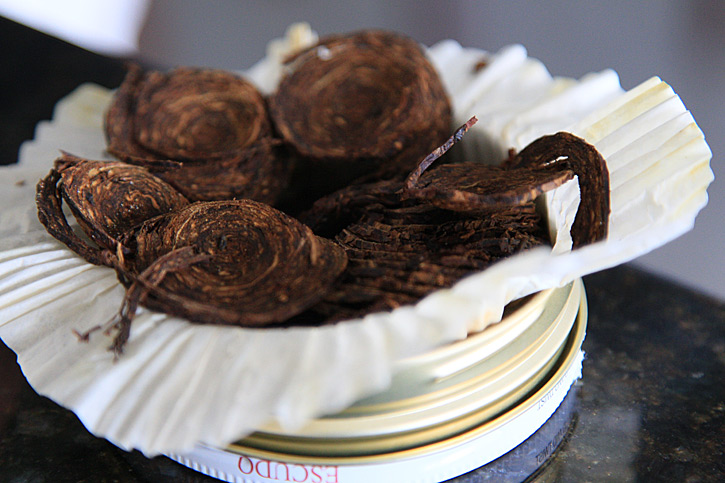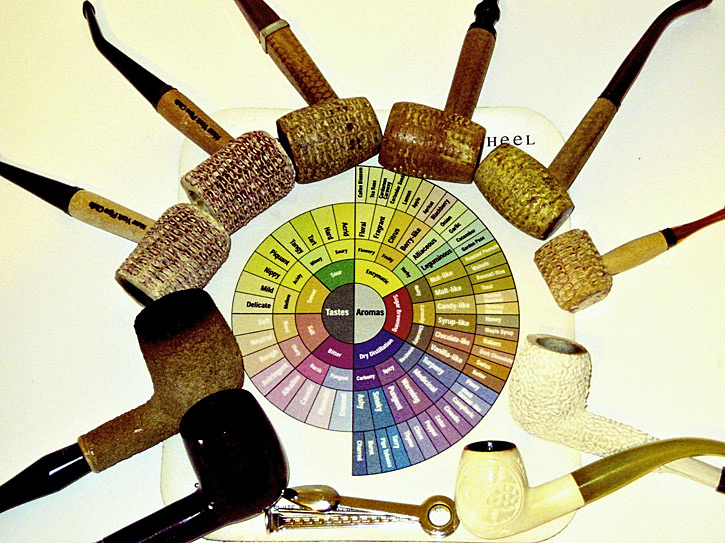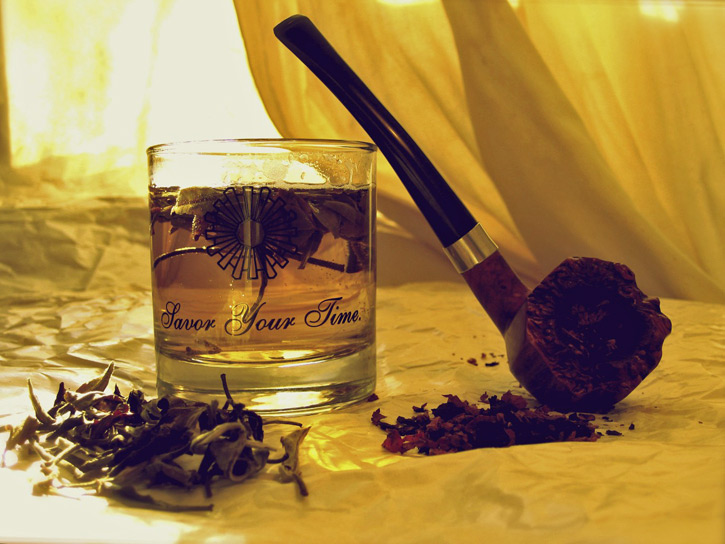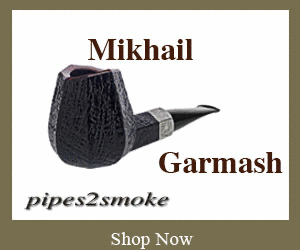E. Roberts
I’m often asked, "How do you taste so good?" to which I reply that in a former life I was a chocolate éclair. Seriously, though, reviewing tobaccos for publication is a bit of work, but perhaps not as trying as one might think. People often tell me they don’t have as refined a palate as I do, or some other such nonsense, like, "I don’t know how to describe the taste; I only know what I like and what I don’t." To this I say poppycock and balderdash. If you can discern the difference between blend A and blend B, or hot dogs and chocolate éclairs for that matter, then your palate is refined enough. If you truly can’t, then stop reading right here and buy the cheapest tobacco available, because it won’t matter what you smoke. For the rest of us, our own rich experience is all the background we need for tasting—that, and a willingness to trust our own judgment.
To borrow a line from PipesMagazine.com’s own Brian Levine, we are all experts of our own opinion. The main qualifications in being such an expert are a confidence in one’s perception and the desire to define it, which I believe all of us are capable of doing when we allow ourselves to be. Whether you’re interested in simply keeping your own journal of tasting notes, chatting about the latest releases with the guys at the pipe club, or learning how to more effectively communicate to others for publication, you’ll find it remarkably easy to equip yourself with the tools and strategies necessary to fully interpret and profile your tobaccos. My own pipe taste-testing regimen is evolved and adapted from what I learned during my time in the specialty coffee industry, as well as a hobbyist’s experience with wine, spirit and food tastings.

1) Clean Palate, Clean Mind
As a painter starts with a blank canvas, so a critical assessment begins with a blank palate. Basic oral hygiene is a must for pipe smokers—brush, floss and especially mouthwash regularly, and additionally an hour or so before you plan to do a taste-testing. Proper hydration while smoking is another must. For smokes in which I’m trying to tease out every nuance of a blend, I limit my accompaniment to water, generally a sparkling mineral water. Other times I’ll pair with a tea, occasionally a spirit, and vary them a bit to accommodate the blend. I don’t burn any candles or incense, I don’t cook, and I request that the woman of the house not try out perfumes while taste-testing—all of which seem rather obvious, but bear stating for the record. I’ll also abstain from smoking anything other than the blend I intend to inspect for the day, and generally will smoke that tobacco to the exclusion of all else for at least a few days to allow my palate (and pipe) to adjust—each tobacco has its own chemistry, and it may take me some time to acclimate to it. Incidentally, I find this is one of the best ways to preclude tongue bite; often when a blend bites it’s a matter of the chemical balance between the tobacco and my body at that moment, and by allowing my palate to remain clear and slowly introducing the blend, I find that equilibrium is achieved in a short time and I can smoke repeated bowls of nearly anything with nary a nip.
2) The Importance of Time
In order to honestly and fully examine a tobacco in a critical manner, it is imperative to clear out any distractions and focus on the task at hand. That is not to say that one must be sequestered in a clean room with a starched white lab coat to enjoy a bowl; rather, when intending to review a tobacco critically, make it a point to do nothing but smoke that blend and focus on that experience at least a couple of times over the course of a tin. I set aside a couple hours of uninterrupted tasting time to get to know a blend—no watching a movie or balancing my checkbook or knitting; just smoking, and taking notes. Try it with an old favorite blend sometime, and you may be surprised at the new flavors you find.

3) Tools of the Trade
Keeping a journal is essential to record your experience with a tobacco. You’ll note that for this month’s review of Maple Street from Sutliff, for example, that I’ve kept tasting notes going back over two and a half years and numerous tins from which to develop my critical evaluation. This is an important point to make: a flavor profile is something that will develop over the course of several bowls, several tins or even several pounds of a given blend. In this way you can also develop a sense of how a blend may change over time, and foster an articulate insight into the effects of aging.
Far be it from me to enable anyone’s PAD, but to profile blends on any regular basis, it will be beneficial to employ a small arsenal of pipes of varying size, chamber, draught, and even material. If you have the means and inclination, a couple of good quality meerschaums and clays can’t be beat for burning your tobacco in as neutral an environment as possible. Pipes should be well broken-in and clean, with minimal cake. Missouri Meerschaum corncob pipes are an unbeatable choice for filling out your stable: affordable, maintainable and available in a range of sizes, they make perfect sampling pipes as well as being particularly suited to aromatic and burley-forward blends. While they will impart some small flavor to a tobacco, this effect can be blunted with the same breaking-in and cleaning regimen you’d employ for briars. Wood pipes too impart the ghosts of their previous contents, so it again becomes essential to both compile notes over time, as well as invest the effort to smoke the same blend from the same pipe for a while once an agreeable pairing has been made.
A tasting wheel (or aroma wheel) is a valuable aid to assist in discerning the nuances of a blend. First developed by a sensory chemist for describing the aromas in wine, the concept of the adjacency diagram to delineate flavors and aromas in foods has led to hundreds of incarnations for everything from coffee to maple syrup and, of course, tobacco. I employ a variety of them garnered from the Interwebs, pinned to the walls around my writing desk and even under my mouse.

Flavor wheel and the arsenal used to taste-test this month’s review tobacco.
4) Address the Tobacco
Wine, coffee, tobacco or chocolate éclairs, the taste-testing protocol is the same: appraise it with the eyes, then with the nose, and finally the palate. When approaching a new blend, take copious notes upon cracking the tin—there is great value in first impressions. There’s nothing comparable to the whooshing burst of aroma as the seal is broken and the tobacco is awakened to air after months or years of anaerobic slumber in the tin, and those first notes are often the clarion call of a blend’s characteristics. Conversely, all the many variables that affect our perception of taste, as well as the tobacco itself, will change over the course of time. Again, don’t expect to completely dissect a blend in a single smoke. Freshly opened tins tend to be boisterous in terms of aroma and flavor, and settle down after they have stabilized to their new environment.
Inspect the tobacco visually at first, from tin art to price point to the cut and color of the leaf itself. This is all part of its presentation, and any good chef knows we eat with our eyes first. I generally stuff my face right down in the tobacco and inhale deeply and repeatedly. I’ll then pull some out, rolling it around in my fingers to get a feel for its moisture and cut. Often I’ll even take a pinch to chew on briefly, in order to get a sense of the presence or lack of additives and the natural flavors of the leaf.
Following this preliminary inspection, we’re ready to engage our other senses in the ritual of the pipe. Pack and light it according to your preferred methods or the demands of the cut, and again, do nothing but smoke and take notes for the duration of a bowl. Note its burning characteristics, whether or not it takes a light easily and its ability to maintain an ember; even listening to it as it burns can tell us something about its moisture and makeup. Often you’ll need to make minor adjustments along the way as you get to know a blend to find the combination of pipe and packing method that brings out the best attributes of a tobacco. Note that there are three distinct portions to a bowl—the top (after the "true" light), the middle, and the heel (or bottom), and that burning temperatures (and thus flavor) will vary during these segments. Pay attention to relights, the body of the smoke and the mouthfeel, and keep your journal ready for those moments of inspiration that bring insight into the flavors at hand. For describing the room note, it helps to leave the smoking area for several minutes before returning in order to reset your sense of smell. Alternatively, you could ask an innocent bystander what they think, though this may not always provide the insight you seek.
5) Say What? Putting It All Together
Preparation is a key ingredient in ensuring success at profiling. When smoking a blend critically, I’m searching for those flavors that stand out on their own without stretching to find them. I’ve had some experience with this professionally in the world of coffee, and part of that training involved simply seeking out a lot of those common tastes on the flavor wheel and coaching my palate to recognize them. Building a tasting vocabulary is something everyone can do. I repeat: THIS IS SOMETHING EVERYONE CAN DO. Don’t be intimidated by "notes of Meyer lemon"—simply educate your own palate by picking up a Meyer lemon and a "regular" (i.e., Eureka or Lisbon) lemon, cutting them up, chewing on them, comparing them, and maybe keeping some notes to refer back to. The point of analogizing the flavors experienced during a smoke with common foods or aromas is to create a reference point to which others (or your own failing memory) can relate as a guide. Also realize that taste, like the perception of color, is highly individual, yet within a general frame of reference—two people may not taste "citrusy" in exactly the same way, but by noting a Meyer lemon rather than a "regular" lemon, both should expect a rounder sweetness that is less tart and more floral. Often with tobacco the nuance is a matter of fractions of a degree, and one should always aim for as much accuracy as is possible. Trips to the grocery store or even your own kitchen are educational for your nose and palate, and should be treated as such. You’ll be surprised at how quickly and accurately you’ll be able to describe different flavors in a very short time.
"What’s up with all those crazy, flowery descriptions? Citrusy this, stewed plum that, Tasmanian honey wrapped in polyphenolic falderal…come on, really?" The subject of purple prose in reviews is as old as the Bulwer-Lytton contest, if not older. I myself am most certainly culpable of it, considering it a writer’s guilty pleasure. At the end of the article, though, I hope to have at least conveyed a sense of what the experience was like for me, and how it may be for you. Remember that even the best-written review is only one person’s opinion. The lesson here is to record what you know, make it relatable to your experience, and make it valid to your own judgments and purposes.
Your own journey might begin simply with, "That’s a good tobacco." After some time it may progress to, "I really like the rich fruity tastes in this blend and it smokes nicely;" then after a time it may become, "This is a great Va/Per blend, richer than most with its higher Perique content, and developing a depth with some aging time that is really carried well by the spun flake cut." It’s not that you taste anything that wasn’t there all along; it’s that you’ve trained yourself to catalogue, compare and contrast all the aspects that are available to your senses. The smoker with more knowledge of what appeals to him certainly shortens his journey to bliss. Always remember that, above all else, tobacco taste-testing should be an enjoyable and educational experience for you; if you find it becoming too much work, ease back a little and remember you’re here to savor your time.
















Great article. Being a home coffee roaster, I can relate to the explanation of conveying flavor nuances and similarities between tobacco and coffee in some instances.
Quite right, javaman. Perhaps I’m biased, but coming from the background of coffee and tea buying and retailing, it was a natural lateral move to profiling tobaccos.
For me, this article was both informational and instructive. Most pipe smokers who take the time to enjoy the ritual of smoking a pipe probably follow these steps in an informal way. The article highlights that a pipe smoker needs to give a tobacco several chances to reveal its full flavor. However, as for making notes, mine will have to be mostly mental until I retire!
Thanks for a very insightful and well articulated examination of the tobacco reviewing process. What resonates with me the most is the importance of developing a vocabulary suited to the purpose. Additionally, I think a reviewer should be guided by a checklist to ensure that nothing is overlooked, and that characteristics are covered consistently from one review to another.
I really like the writer’s insistence that almost anybody could write good reviews if they are of a mind to do so. As they involve more discrimination than is usual while I smoke, I find writing them a worthy goal. I feel that anything that I can work toward in pipe smoking produces more benefit than cost.
@momeerphil–Don’t wait that long! A pocket-sized composition notebook is all you need to keep handy, and once you start jotting down notes here and there you’ll be amazed at how easy it becomes to keep going (and if your inclination permits, to expand on those notes).
.
@Cortez–Indeed, I do just that for my personal journal keeping. As can be seen in the photo accompanying the Maple Street review ( http://bit.ly/MapleStreet ) my handwriting is atrocious, and random scribblings are often kept in several notebooks concurrently, but are then collated into my master notebook in much more orderly fashion. In the master notebook I have pre-printed my checklist of points to cover. I’ve been deliberating the notion of making this available to interested parties…any takers?
.
@4nogginsmike–I find myself saying this time and again to friends at the pipe club; it’s nothing that you don’t already do when you smoke, other than making note of your observations. The few who have tried it have been impressed with themselves, I’m pleased to report. “I feel that anything that I can work toward in pipe smoking produces more benefit than cost.” is spot on! Thanks Mike.
Great article!
What pipe is that in the last picture? I love plateau tops and paneled pipes, so I’m completely enamored by it. I’ll need to add it to my PAD list.
That’s a Tim West freehand, algenib. Nickel band, 1/4 bent, and I’d call it a take on a paneled author shape. In general I really don’t go for freehands or plateau tops–this is the only one in my collection–but something about this pipe grabbed me when I saw it, and it’s just a fantastic smoker. The bowl geometry is such that densely complex blends seem to loosen some of their knots, making individual threads of flavor more easily discernible. I’m about to load it up with some Vincent Manil Semois right now, finishing the next review in fact.